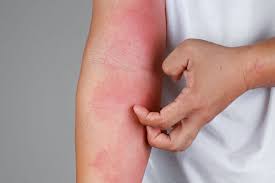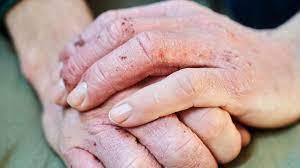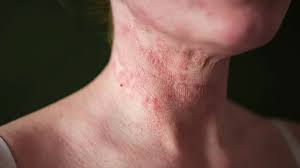Dyshidrotic eczema, Pompholyx, Acute palmoplantar eczema.
Root Cause of Disease
Stress can trigger dyshidrotic eczema. Some people find that dyshidrotic eczema flares only at certain times. You may develop dyshidrotic eczema only when you feel stressed out. Many people say blisters appear when stress hits and continue to appear until their stress lessens.
Symptoms
- Fluid-filled blisters form on your fingers, toes, palms, and the soles of your feet.
- These blisters may itch or hurt.
- Your skin can scale, crack, and flake.
Causes
Dyshidrotic eczema can be caused by:
- allergies
- damp hands and feet
- exposure to substances, such as nickel, cobalt, or chromium salt
- stress
- smoking tobacco products
Home Remedies to treat Dyshidrotic Eczema
Remedy- 1:
Materials Used: Coconut oil

A person can apply virgin or cold-pressed coconut oil directly to eczema to help moisturize the area and reduce bacteria. A person should use it once or twice per day on damp skin.
Product Link: Coconut Oil
Remedy – 2:
Materials Used: Sunflower oil

Sunflower oil may help improve the skin’s protective barrier and reduce inflammation. A person should apply for it twice a day.
Product Link: Sunflower Oil
Remedy – 3:
Materials Used: Honey

Honey, applied topically, has antibacterial and antiseptic properties.
Procedure:
- Apply honey to the affected area.
- massage and apply more if needed.
Product Link: Honey
Other Remedies
Tea Tree Oil
Tea tree oil has anti-inflammatory properties that could soothe irritation and is great for treating eczema. To use tea tree oil, you must first mix it with a carrier oil such as jojoba oil. This is because using tea tree oil in its undiluted state could cause certain side effects such as minor irritation which could make eczema worse.
Turmeric
Turmeric is one of the eczema home remedies in India. It is anti-inflammatory and has wound healing properties which makes it a great option when treating eczema. To use this herb, you can mix a spoonful of turmeric powder with some honey and apply it to the affected area. Let it sit for a few minutes before washing it off with water.
Apple Cider Vinegar
Eczema can also be treated using apple cider vinegar. To do this, add about two portions of apple cider vinegar to a warm bath. This will help in reducing inflammation on the skin and also reduce dryness.
Preventions
- Remove your rings before you:
- Wash your hands
- Apply moisturizer
- Go to sleep
Rings can irritate your sensitive skin. Removing your rings as listed above may prevent irritation.
- Wash skin with dyshidrotic eczema gently: When washing, you’ll want to:
- Remove rings: Always remove these before washing your hands. If the skin beneath gets wet and stays damp, this could cause a flare-up.
- Use lukewarm water: Using lukewarm water every time can help prevent flares.
- Wash with mild, fragrance-free cleansers: Skip the antibacterial soaps, and deodorant soaps, which can cause dyshidrotic eczema to flare.
- Ask your dermatologist to recommend a hand sanitizer: If you have hypersensitivity to an ingredient in a hand sanitizer, it can cause a flare-up.
- Apply moisturizer (or barrier repair cream) frequently throughout your day: Dyshidrotic eczema leaves you with extremely dry skin. The best times to apply your moisturizer or barrier repair cream are:
- After washing
- Whenever your skin feels dry
Your dermatologist may recommend using a product called a barrier repair cream that contains dimethicone. This product allows your skin to breathe while creating a barrier that protects your skin from irritation.
- Learn to manage stress really well: Some patients find that their skin clears with effective stress reduction and treatment prescribed by their dermatologist.
One stress reduction technique has proven especially effective in small studies. It’s called biofeedback therapy. Some patients have been able to clear their skin — and keep it clear — by practicing biofeedback therapy. - Try to avoid scratching: Anything you can do to reduce scratching is helpful because scratching tends to worsen dyshidrotic eczema.
- Take precautions in very dry or hot conditions: Heat, dryness, and sweat are known to trigger dyshidrotic eczema. Try to avoid getting overheated by staying cool. To protect your skin from becoming excessively dry, apply moisturizer frequently.
- Avoid what causes an allergic reaction or irritates your skin: If either allergens or irritants are the problem, avoiding them may be necessary to clear your skin — and keep it clear.
If you’re uncertain about what can cause an allergic reaction or irritate your skin, see your dermatologist. Testing can help you know what to avoid. - Protect your hands with gloves: Many things that touch your skin can cause dyshidrotic eczema to flare. Water, detergents, and household cleaners are a few. Even washing dishes or painting could cause dyshidrotic eczema to flare.
To protect your hands, dermatologists recommend that you put gloves on before you get your hands wet and before touching something that could irritate your skin. - Wear moisture-wicking socks: If you have dyshidrotic eczema on your feet, this will help keep your feet dry.




